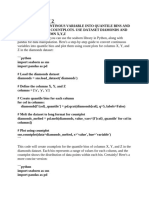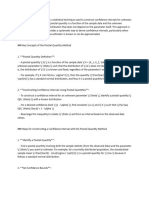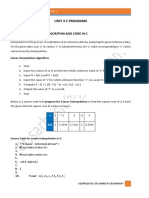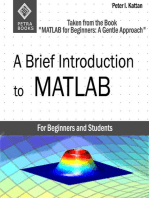m&Sf Short Answers
m&Sf Short Answers
Uploaded by
rajalaraveendraredyCopyright:
Available Formats
m&Sf Short Answers
m&Sf Short Answers
Uploaded by
rajalaraveendraredyCopyright
Available Formats
Share this document
Did you find this document useful?
Is this content inappropriate?
Copyright:
Available Formats
m&Sf Short Answers
m&Sf Short Answers
Uploaded by
rajalaraveendraredyCopyright:
Available Formats
---
### **Unit-I: Greatest Common Divisor and Related Topics**
1. **Define Greatest common divisor (GCD).**
The GCD of two integers is the largest integer that divides both numbers without leaving a
remainder.
2. **Find GCD of 28 and 36 by using the method of factors.**
- Factors of 28: \( 1, 2, 4, 7, 14, 28 \).
- Factors of 36: \( 1, 2, 3, 4, 6, 9, 12, 18, 36 \).
- Common factors: \( 1, 2, 4 \).
- GCD = 4.
3. **Find GCD of 18 and 24 by using the method of prime factorization.**
- Prime factors of 18: \( 2 \times 3^2 \).
- Prime factors of 24: \( 2^3 \times 3 \).
- Common factors: \( 2 \times 3 = 6 \).
- GCD = 6.
4. **State the Euclidean algorithm of GCD.**
The Euclidean algorithm computes GCD by repeated division:
\( GCD(a, b) = GCD(b, a \mod b) \), until \( b = 0 \).
5. **Find the H.C.F of 126, 162, and 180 using the Fundamental Theorem of Arithmetic.**
- Prime factors of 126: \( 2 \times 3^2 \times 7 \).
- Prime factors of 162: \( 2 \times 3^4 \).
- Prime factors of 180: \( 2^2 \times 3^2 \times 5 \).
- Common factors: \( 2 \times 3^2 \).
- HCF = 18.
6. **Define Fermat numbers.**
Fermat numbers are of the form \( F_n = 2^{2^n} + 1 \), where \( n \geq 0 \).
7. **Define congruences.**
Congruence refers to equivalence modulo \( m \):
\( a \equiv b \ (\text{mod } m) \) if \( m \) divides \( (a - b) \).
8. **Explain the congruence equation \( a = b (\text{mod } m) \).**
\( a \equiv b (\text{mod } m) \) means \( a = b + km \), where \( k \) is an integer.
9. **Define Linear congruences.**
A linear congruence is an equation of the form \( ax \equiv b (\text{mod } m) \).
10. **Prime factorization of 460 using the division method.**
\( 460 \div 2 = 230 \), \( 230 \div 2 = 115 \), \( 115 \div 5 = 23 \) (prime).
Prime factors: \( 2^2 \times 5 \times 23 \).
---
### **Unit-II: Correlation, Regression, and Probability**
1. **Define Correlation.**
Correlation measures the strength and direction of the relationship between two variables.
2. **Define Regression coefficients.**
Regression coefficients represent the slope of the regression line, showing the change in
the dependent variable for a unit change in the independent variable.
3. **Define fitting of Least squares.**
The least squares method minimizes the sum of squared differences between observed
and predicted values in regression analysis.
4. **Define Random variable.**
A random variable assigns numerical values to the outcomes of a random experiment.
5. **Define Discrete Random variable.**
A discrete random variable takes on a countable number of distinct values.
6. **What is Mathematical Expectation?**
The mathematical expectation (or expected value) is the weighted average of all possible
values of a random variable.
7. **Given \( P(a \leq x \leq 1) = \frac{19}{81} \), find \( a \).**
Integrate \( f(x) = x^2 \) over \( [a, 1] \):
\( \int_a^1 x^2 dx = \frac{19}{81} \). Solve to find \( a \).
8. **Define Binomial Distribution.**
A binomial distribution describes the number of successes in \( n \) independent trials,
each with success probability \( p \).
9. **Show that the mean and variance are equal for Poisson distribution.**
For a Poisson distribution, \( \mu = \lambda \) and \( \sigma^2 = \lambda \), so mean =
variance = \( \lambda \).
10. **If the mean of a Poisson distribution is 1.8, find \( P(x = 5) \).**
Use \( P(x = k) = \frac{e^{-\lambda} \lambda^k}{k!} \).
Substituting \( \lambda = 1.8 \), \( k = 5 \).
---
### **Unit-III: Distributions and Sampling**
1. **Define Normal Distribution.**
A normal distribution is a symmetric bell-shaped distribution defined by its mean and
variance.
2. **Define Central Limit Theorem.**
The CLT states that the sampling distribution of the sample mean approaches a normal
distribution as the sample size increases.
3. **Write the uses of Normal Distribution.**
- Modeling natural phenomena.
- Statistical inference.
- Quality control.
4. **Define Sampling distribution.**
A sampling distribution is the probability distribution of a statistic computed from a sample.
5. **Properties of \( t \)-distribution and \( F \)-distribution.**
- \( t \)-distribution: Symmetric, heavier tails than normal.
- \( F \)-distribution: Skewed, non-negative values.
6. **Define Random Sampling method.**
Random sampling selects elements from a population where each has an equal chance of
being chosen.
7. **Define population and sample.**
- Population: Entire set of elements.
- Sample: Subset of the population.
8. **Define Finite and Infinite Population.**
- Finite: Limited number of elements.
- Infinite: Countless elements.
9. **Find the finite population correction factor for \( n = 10 \) and \( N = 100 \).**
Correction factor: \( \sqrt{\frac{N - n}{N - 1}} \).
10. **In which distribution are mean, median, and mode equal?**
Normal distribution.
---
### **Unit-IV: Hypothesis Testing**
1. **Define Unbiased Estimator.**
An estimator is unbiased if its expected value equals the parameter it estimates.
2. **What is the formula for maximum error?**
Maximum error = \( z \cdot \frac{\sigma}{\sqrt{n}} \), where \( z \) is the z-score.
3. **Define Null hypothesis and Alternative hypothesis.**
- Null hypothesis (\( H_0 \)): No effect or difference.
- Alternative hypothesis (\( H_a \)): Effect or difference exists.
4. **Explain Type I and Type II error.**
- Type I: Rejecting \( H_0 \) when it is true.
- Type II: Failing to reject \( H_0 \) when it is false.
5. **What is meant by level of significance?**
The probability of rejecting \( H_0 \) when it is true, denoted by \( \alpha \).
6. **Write the confidence interval for true mean.**
\( \bar{x} \pm z \cdot \frac{\sigma}{\sqrt{n}} \).
7. **Explain the procedure generally followed in testing hypotheses.**
- Define \( H_0 \) and \( H_a \).
- Choose \( \alpha \).
- Calculate the test statistic.
- Compare with the critical value.
- Make a decision.
8. **What is the test statistic for large samples?**
Z-test.
9. **What is the test statistic for small samples?**
T-test.
10. **Differentiate two-tailed and one-tailed tests.**
- One-tailed: Tests for a specific direction.
- Two-tailed: Tests for any difference.
---
### **Unit-V: Stochastic Processes**
1. **Define stochastic process.**
A stochastic process is a collection of random variables indexed by time or space.
Example: Stock prices.
2. **Define deterministic and non-deterministic stochastic processes.**
- Deterministic: Future states are fully determined by current states.
- Non-deterministic: Contains randomness.
3. **Define transition matrix.**
A transition matrix describes probabilities of moving from one state to another in a Markov
process.
4. **Define Markov process.**
A stochastic process where future states depend only on the current state.
5. **Define Markov Chain.**
A sequence of random states with the Markov property.
6. **Define Stochastic matrix.**
A matrix where rows represent probability distributions, summing to 1.
7. **Define Regular matrix.**
A stochastic matrix where some power has all positive entries.
8. **Define an Absorbing Markov Chain.**
A Markov chain with at least one absorbing state.
9. **Define probability vector.**
A vector whose entries are non-negative and sum to 1.
10. **Test if the following matrix is stochastic:**
\[
\begin{bmatrix}
1/3 & 2/3 & 4/3 \\
1/2 & 1 & 1/2
\end{bmatrix}
\]
**Not stochastic** because row sums do not equal 1.
You might also like
- Strategic Marketing Ch7Document20 pagesStrategic Marketing Ch7Tariq JaleesNo ratings yet
- Math For CSIndetailbyvhdcDocument12 pagesMath For CSIndetailbyvhdcvrajh patelNo ratings yet
- Maths Notes Class 10 CBSE DDS PUBLIC SCHOOLDocument14 pagesMaths Notes Class 10 CBSE DDS PUBLIC SCHOOLchowpromo295No ratings yet
- Linear Algebra ReviewerDocument7 pagesLinear Algebra Reviewerlojofol331No ratings yet
- randomDocument4 pagesrandomaadhitho97No ratings yet
- Forumales - Research MethodologyDocument3 pagesForumales - Research Methodologysn9054No ratings yet
- Project 2 MathDocument4 pagesProject 2 Mathtammy.cainNo ratings yet
- exercises in Artificial IntelligenceDocument5 pagesexercises in Artificial IntelligenceazizatalebNo ratings yet
- Downloadfile 1Document2 pagesDownloadfile 1mo haNo ratings yet
- Easy TestDocument3 pagesEasy TestrodtherexNo ratings yet
- Documents 1Document7 pagesDocuments 1abhinav sureshNo ratings yet
- Assignment 2Document12 pagesAssignment 2aryan540787No ratings yet
- DCS PDFDocument11 pagesDCS PDFviswagnya saiNo ratings yet
- MATH9Document4 pagesMATH9GabeeNo ratings yet
- Hello World TestDocument6 pagesHello World Testmjquilario39No ratings yet
- Stiffness MethodDocument3 pagesStiffness MethodThapeloNo ratings yet
- AlgebraDocument2 pagesAlgebraAnish S TaklikarNo ratings yet
- Probablity NotesDocument4 pagesProbablity Notesapurba.sapkota2008No ratings yet
- AlgebraDocument2 pagesAlgebraguyusher02No ratings yet
- The Pivotal QuantityDocument3 pagesThe Pivotal QuantityJojo BasarNo ratings yet
- NL Lab Ivsem EceDocument63 pagesNL Lab Ivsem EceMallik ArjunaNo ratings yet
- 대학 수학 문서Document4 pages대학 수학 문서j.ace.holland264No ratings yet
- ECE OOP Lab4Document4 pagesECE OOP Lab4tonynghia0812No ratings yet
- LabDocument5 pagesLabPrashant RawatNo ratings yet
- Re 1Document7 pagesRe 119220No ratings yet
- Fds Solved 3Document30 pagesFds Solved 3subodhdudhmal123No ratings yet
- Detailed Report UncertaintiesDocument6 pagesDetailed Report UncertaintiesSahli MohamedNo ratings yet
- Python Lab Experiments With Algm_n_codeDocument33 pagesPython Lab Experiments With Algm_n_codeanndriyasNo ratings yet
- Math Exam Morocco 2020Document3 pagesMath Exam Morocco 2020mo haNo ratings yet
- Sources of Magnetic FieldsDocument25 pagesSources of Magnetic FieldsTarcisio KamauNo ratings yet
- Single System LabDocument4 pagesSingle System Labahfarhan06No ratings yet
- Matrix MultiplicationDocument7 pagesMatrix MultiplicationLn Amitav BiswasNo ratings yet
- Finite Element AnalysisDocument5 pagesFinite Element AnalysisThapeloNo ratings yet
- Advanced Software Testing and Quality Assurance Assignmnet by Ravi RajDocument2 pagesAdvanced Software Testing and Quality Assurance Assignmnet by Ravi Rajravi rajNo ratings yet
- Fall 2014, University of Houston Instructor: Dr. K. B. NakshatralaDocument3 pagesFall 2014, University of Houston Instructor: Dr. K. B. NakshatralaAmit JainNo ratings yet
- Exercise 2: Gaussian EliminationDocument8 pagesExercise 2: Gaussian EliminationBea OroNo ratings yet
- UCS751_LAB_FILEDocument38 pagesUCS751_LAB_FILEAvantika RainaNo ratings yet
- Design and Analysis of Algorithms Lab Aman DubeyDocument11 pagesDesign and Analysis of Algorithms Lab Aman DubeyRythmNo ratings yet
- MATH 1201-01 - AY2024-T5 Written AssignmentDocument8 pagesMATH 1201-01 - AY2024-T5 Written Assignmentkwameworae87No ratings yet
- MatricesDocument1 pageMatricesAravindh MNo ratings yet
- Matrices.: X Ly 2 2 K K PDocument23 pagesMatrices.: X Ly 2 2 K K PNarasimma Pallava DudesimNo ratings yet
- C Programming Basic ProjectsDocument7 pagesC Programming Basic ProjectsNeenaNo ratings yet
- Java Metode Gauss JordanDocument7 pagesJava Metode Gauss JordanAriga IrantoNo ratings yet
- Gauss Elimination Lab ReportDocument10 pagesGauss Elimination Lab ReportMukul KhinchiNo ratings yet
- saksham MATLABDocument35 pagessaksham MATLABlasveofficialNo ratings yet
- Practice TestDocument2 pagesPractice TestsokfNo ratings yet
- To Verify the Distributive PropertiDocument3 pagesTo Verify the Distributive Propertiadithyanayak89No ratings yet
- C Program For Unit 3Document9 pagesC Program For Unit 3Er SarbeshNo ratings yet
- Solving Simultaneous EquationDocument7 pagesSolving Simultaneous Equationbryan owusuNo ratings yet
- Ex 2 SolutionDocument13 pagesEx 2 SolutionMian AlmasNo ratings yet
- Assignment.2 Book Code 5404Document15 pagesAssignment.2 Book Code 5404Dream AccademyNo ratings yet
- mypdf-2Document5 pagesmypdf-2X YNo ratings yet
- NSU244 CH 9Document16 pagesNSU244 CH 9Atiqul IslamNo ratings yet
- Calculate the Standard Deviation and Variance From the Following DataDocument24 pagesCalculate the Standard Deviation and Variance From the Following Datavadanyadubey55No ratings yet
- Modal FRA With NastranDocument13 pagesModal FRA With Nastran5colourbalaNo ratings yet
- PS - Lab - Manual - 4th - Sem (1) ANILDocument19 pagesPS - Lab - Manual - 4th - Sem (1) ANILas2225315No ratings yet
- FunctionsDocument2 pagesFunctionssoyu.majNo ratings yet
- Data Science 6th Sem CS Engineesring QuestionsDocument35 pagesData Science 6th Sem CS Engineesring Questionsmrharshitha793No ratings yet
- Calculus Unit 1 TestDocument5 pagesCalculus Unit 1 TestDynafrom100% (7)
- A Brief Introduction to MATLAB: Taken From the Book "MATLAB for Beginners: A Gentle Approach"From EverandA Brief Introduction to MATLAB: Taken From the Book "MATLAB for Beginners: A Gentle Approach"Rating: 2.5 out of 5 stars2.5/5 (2)
- Factoring and Algebra - A Selection of Classic Mathematical Articles Containing Examples and Exercises on the Subject of Algebra (Mathematics Series)From EverandFactoring and Algebra - A Selection of Classic Mathematical Articles Containing Examples and Exercises on the Subject of Algebra (Mathematics Series)No ratings yet
- Young Engineer's Structural Pocket BookDocument15 pagesYoung Engineer's Structural Pocket BookR kar hein100% (3)
- Summary of Safety and Effectiveness Data (Ssed) : I. General InformationDocument36 pagesSummary of Safety and Effectiveness Data (Ssed) : I. General InformationLong An DoNo ratings yet
- 123 Oris Novi Pocetak ApartmanizacijeDocument6 pages123 Oris Novi Pocetak ApartmanizacijemmrduljasNo ratings yet
- Get (Ebook PDF) C++ Without Fear: A Beginner's Guide That Makes You Feel Smart 3rd Edition Free All ChaptersDocument51 pagesGet (Ebook PDF) C++ Without Fear: A Beginner's Guide That Makes You Feel Smart 3rd Edition Free All Chaptersbeusanbhujoo100% (4)
- Modern Symmetric Block CiphersDocument137 pagesModern Symmetric Block CiphersTrisNo ratings yet
- SLRC ClassIV 071024 Vacancies NoticeDocument1 pageSLRC ClassIV 071024 Vacancies Noticecijalov197No ratings yet
- Alan Lu: EducationDocument1 pageAlan Lu: EducationDr. Vivek SrivastavaNo ratings yet
- AcCommandWeight XMLDocument23 pagesAcCommandWeight XMLSam MeshramNo ratings yet
- Introduction To Cellular Mobile SystemDocument6 pagesIntroduction To Cellular Mobile Systemkhushijahnvi20No ratings yet
- Method Statement: SUB - Dismantling Activities For Upto 15 MTRDocument4 pagesMethod Statement: SUB - Dismantling Activities For Upto 15 MTRMichael AgnaelNo ratings yet
- Juk Mo-3904 3914 3916Document44 pagesJuk Mo-3904 3914 3916RHoskaNo ratings yet
- Product Design RoadmapDocument5 pagesProduct Design Roadmapaasthaagarwal1729No ratings yet
- Dosatron d14mz3000 Injector TroubleshootingDocument21 pagesDosatron d14mz3000 Injector TroubleshootingFábrica BoulevardNo ratings yet
- CTC 3D Printer ManualDocument38 pagesCTC 3D Printer ManualNimmala Ganesh100% (1)
- Chapter 14-2 - Applications of Linear Optimization - Transportation ProblemDocument5 pagesChapter 14-2 - Applications of Linear Optimization - Transportation ProblemPankaj MaryeNo ratings yet
- Plc حل 12 شبتر-46-68Document23 pagesPlc حل 12 شبتر-46-68Abdelrhman AbdullahNo ratings yet
- Brands Listening ExerciseDocument1 pageBrands Listening ExerciseyurannyNo ratings yet
- An Introduction To Mathematical Methods in CombinatoricsDocument100 pagesAn Introduction To Mathematical Methods in Combinatorics@bhiNo ratings yet
- Bridging The Skills Gap Fuelling Careers and The Economy in IndiaDocument7 pagesBridging The Skills Gap Fuelling Careers and The Economy in IndiaMadlearner 3No ratings yet
- Part S15 Driven Piles (2012)Document5 pagesPart S15 Driven Piles (2012)CK TangNo ratings yet
- 221121_installation_instructions_EN_HYC50_MAN_Software_V1-2Document76 pages221121_installation_instructions_EN_HYC50_MAN_Software_V1-2Leonardo Andres MagiNo ratings yet
- Bab 2 Bahasa Inggris Frangklif Rafel Pinontoan (20024017)Document3 pagesBab 2 Bahasa Inggris Frangklif Rafel Pinontoan (20024017)Marini PinontoanNo ratings yet
- Delve 2019 State of The Artisanal and Small Scale Mining SectorDocument98 pagesDelve 2019 State of The Artisanal and Small Scale Mining SectoreliotsmsNo ratings yet
- NCSC 201 Discrete Mathematics NotesDocument39 pagesNCSC 201 Discrete Mathematics NotesTawanda NaiteNo ratings yet
- Module 08: Programming C++: Default Parameters & Function OverloadingDocument29 pagesModule 08: Programming C++: Default Parameters & Function Overloadingswaraj bhatnagarNo ratings yet
- CS231 - 2024Document19 pagesCS231 - 2024Shiftain AhmadNo ratings yet
- PCR TLDocument4 pagesPCR TLVivek SontakkeNo ratings yet
- THERMOTEC AUST Thermal Pipe 4 Zero A4 4pp PDFDocument4 pagesTHERMOTEC AUST Thermal Pipe 4 Zero A4 4pp PDFGeorge_Wabag_2014No ratings yet
- ABC-ID Regi Students NoticeDocument1 pageABC-ID Regi Students NoticeAmarnath JADHAVNo ratings yet

























































































